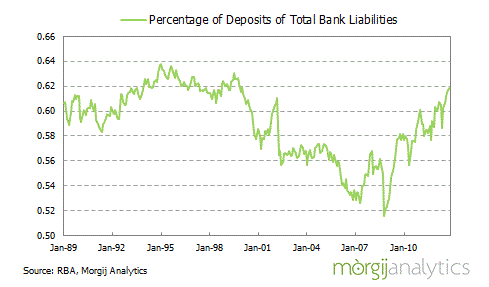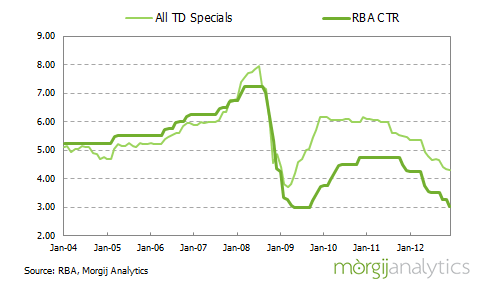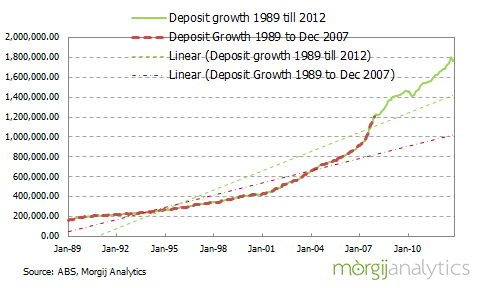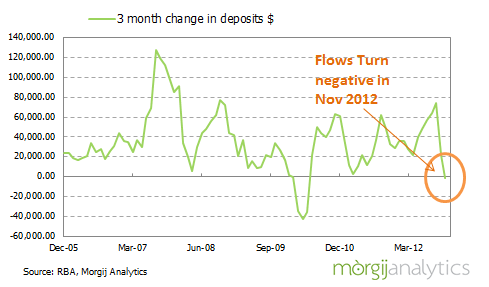
Cross-posted from the MARQAnalytics blog.
Retail deposits are seen as the corner stone of financial institutions stability. The more retail deposits the more comfort bank managers and bank boards are with the stability of their institutions liquidity.
Whilst the optimal level of deposits for any institution is really a matter of their customer base and the type of business they run and operate, one thing is certain and that is that the GFC and the resultant global funding pressure have caused the major banks in Australia to revisit their business model as they seek to re-engage with deposit holders after years of focusing on the asset side of their balance sheet and growth in their home loan book.

It is this re-engagement with deposits and deposit holders that has driven a gathering war among the retail banks as they have successfully increased the share of balance sheet funding that is defined as deposits.
Bank boards and managers have been aided and abetted by APRA and its global regulatory cousins from the BCBS who are pushing the notion of the strength and stickability of retail deposits with the new Basel III liquidity rules.
The problem is that there is only a finite pool of deposits inside any jurisdiction that satisfy the criteria for “retail” under Basel III.
And the question of what is a retail deposit is an interesting one under Basel III. The deposit data used here comes from a combination of the B3 – Banks, B7 – Building Societies and B8 – Credit Unions statistical tables found in the statistics section of the RBA website. In the notes to B3, which is the dominant dollar value of Australian ADI liabilities, the RBA notes:
Resident liabilities – deposits’ include: transaction and non-transaction deposit accounts; and certificates of deposit….. includes both Australian dollar- and foreign currency-denominated (AUD equivalent) deposits. Certificates of deposit relate to both residents and non-residents.
So these deposits clearly aren’t just retail domestic deposits. The competition for deposits has been fierce and has driven up the cost of funds on all deposits but particularly term deposits which have risen well above the RBA Cash Target Rate over recent years for what appears to be the first time in the modern era.

Luckily for Australian ADIs, were it not for an explosion in the amount of deposits available in the Australian financial system the price would have been driven even higher.
Clearly this increase in deposits is related to the GFC which has resulted in domestic and foreign savers wanting to place their money with strong Australian ADI’s within a AAA rated country.
We have seen it with other classes of investors in their appetite for Australian dollars and for Australian bonds. RBA data shows that non-resident holders of Australian Commonwealth Government Securities increased from 48.36% in the June quarter 2009 to 76.64% in June 2012 and it sits at 72.18% at the last reporting date of September 2012. In dollar terms that is an increase from $51.9 billion to $207.5 billion across that time frame. These non-resident funds ultimately flow into Australian ADIs.
Non-residents and locals clearly believe their money is safe in Australia and the Australian banking system. Indeed Australian’s have the first $250,000 in their name, or names, at each ADI guaranteed by the Australian Government. Down from the original unlimited guarantee but still a big number on any global comparison.
The expectation in the design of the deposit guarantee and by bank managers, boards, APRA and the BCBS is that this increase in deposits, particularly the gold standard retail deposits, is very sticky. Money that won’t run away in a crisis.
that may be true. But surely a large part of the deposit flow that has been attracted to the Australian financial balance sheet is also a reflection of the global market and economic turmoil and that this money, like a yacht in storm, is simply resting in a safe harbour during the ongoing global economic storm?
The corollary is that when the storm lifts and the economic sunshine comes out again that the money will be redeployed to more productive or riskier assets as the global economic and market turmoil settles down.
Should, or indeed when, this happens will it leave a hole in the whole Australian financial system’s liquidity bucket?
The answer is possibly yes.
The chart below maps the growth in deposits in the Australian Banking system since 1989. It includes all banks, and the credit union and building society sector.

What we see is the increase in the deposit trend rate of growth in around 2001 and then again materially in 2007 when the GFC first strikes.
Clearly the chart shows a recent change in the amount of deposits no doubt as a reflection of the GFC which has impacted on the savings patterns of Australians. This is also shown in the Australian National Accounts data where the savings rate in Australia has increased back to around 10% of disposable income.
The chart below is of the three month change in deposits held by Australian ADI’s since the end of 2005. It is evident that what might be called “stressed” rather than “hot” money flowed into the banking system in large amounts both in late 2007, when the GFC first kicked off and then again in the back end of 2008 when the GFC intensified during this period. Both these periods were synonymous with extreme stress in global finance.

Indeed supporting the notion that this is stressed money in a safe harbour is the outflow that occurred from deposits in the early part of 2010 when many thought that the crisis was ebbing and before the troubles relating to the Greek debt position ushered in the European sovereign debt crisis in April and May of that year.
The flow of deposits has slowed and is indeed starting to reverse as the latest statistics from the RBA show. These data highlight the reality of a reduction in the 3 month rate of change in deposits by dollar value to September 2012 of +$74.26 billion has turned around to an outflow of -$1.3 billion in the 3 months to November 2012. At this time total deposits in the bank, credit union and building society sector stood at $1.774 Trillion against 1.801 trillion in September 2012.
To put this move in total deposits in context, deposits in the Australian ADI sector fell $27.5 billion from September to November 2012. This is the first time November total deposits have been lower than the September totals since 2000.
As the sun starts to shine on the global economy and as fears of a European catastrophe recede and as investors start to think about redeploying their money, the risk is that Australian ADI balance sheets are vulnerable to a reversal of flow. Even in a subdued credit growth environment the question is how will banks fill this gap if deposit growth slows or reverses if not by collateralised lending via securitisation or covered bond issuance?
We’ll look at how this gap might be filled in part two of this article.

